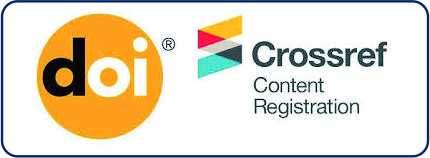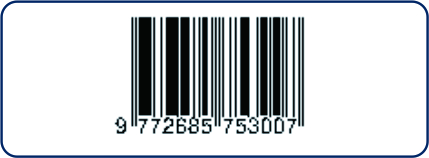Submissions
Author Guidelines
AUTHOR GUIDELINES
General Author Guidelines
1. The article must be scientific (which is substantially contained corpus, perspective, and context), either based on the empirical research or conceptual ideas. The content of the article has not published yet in any Journal, and should not be submitted simultaneously to another Journal.
2. Articles submitted for publication must meet the following conditions:
The article is typed in 1 spacing and the article must be in the range between 15-25 pages, not including title, abstract, keywords, and bibliography, on A4-paper size, with font of "Times New Roman" 12pt with transliteration. (See the journal template).
Writing organizations include: 1) title, 2) author's name (without title), 3) author's agency or affiliation (s), 4) email of author(s), (5) abstract in English and Bahasa Indonesia no more than 250 words, 6) keywords, 7) introduction, 8) discussion, 9) conclusion, and (10) bibliography. The title should not be more than 15 words. Author’s name(s) should be written in the full name without academic title (degree), and completed with institutional affiliation(s) as well as corresponding address (e-mail address). Abstract consisting of the discourses of the discipline area; the aims of the article; methodology (if any); research finding; and contribution to the discipline of areas study. The abstract should be written in English and Bahasa Indonesia. Introduction consisting of the literature review (would be better if the research finding is not latest than ten years) and novelty of the article; scope and limitation of the problem discussed; and the main argumentation of the article. Discussion or description and analysis consisting of the reasoning process of the article’s main argumentation. The conclusion should be consisting of answering research problem, based on the theoretical significance/conceptual construction. All of the bibliography used should be written properly based on Chicago Manual of Style 17th edition (full note), following the example as follows:
Book [example]
Ibnu al-Qayyim al-Jauziyah. Zādu Al-Maʿād Fī Hadyi Khairi Al-ʿIbād. Cetakan ke. Beirut: Mu’assasah al-Risālah, 1994.
Carter, Michael G. Sībawayhi ’ s Principles : Arabic Grammar and Law in Early Islamic Thought. Edited by Joseph E. Lowry Devin J. Stewart, Shawkat M. Toorawa, and International. USA: Lockwood Press, 2016.
Dauda, Kazeem Oluwaseun. “Islamophobia and Religious Intolerance: Threats to Global Peace and Harmonious Co-Existence.” QIJIS (Qudus International Journal of Islamic Studies) 8, no. 2 (December 31, 2020): 257. doi:10.21043/qijis.v8i2.6811.
Mohamed, Hazik. Beyond Fintech: Technology Applications for the Islamic Economy. Edited by Karimah Samsudin. Singapore: World Scientific Publishing, 2021.
Tayeb, Azmil. Islamic Education in Indonesia and Malaysia : Shaping Minds, Saving Souls. New York: Routledge, 2018.
Journal [example]
Dauda, Kazeem Oluwaseun. “Islamophobia and Religious Intolerance: Threats to Global Peace and Harmonious Co-Existence.” QIJIS (Qudus International Journal of Islamic Studies) 8, no. 2 (December 31, 2020): 257.doi:10.21043/qijis.v8i2.6811.
It is suggested the use of a reference manager, MENDELEY and ZOTERO. The order of the bibliography is written alphabetically. Transliteration Arab-Latin follow the guidelines of transliteration.
When a source is cited for the first time, full information is provided: full name(s) of author(s), title of the source in italic, place of publication, publishing company, date of publication, and the precise page that is cited. For the following citations of the same source, list the author’s last name, two or three words of the title, and the specific page number(s). The word ibid., op.cit., and loc.cit. are may not be used any more.
Example in footnotes:
1Mircea Eliade (ed.), The Encyclopedia of Religion, vol. 8 (New York: Simon and Schuster, 1995), h. 18.
2Norman Daniel, Islam and the West (Oxford: One World Publications, l99l), h. 190.
3Mircea Eliade (ed.), The Encyclopedia, h. 119-30.
Detail informations of the footnotes:
- Holy book
Al-Qur’ân, Al-Baqarah/2: 185.
Perjanjian Baru, Mrk. 2: 18.
- Qur’anic translation
1Departemen Agama RI, al-Qur’an dan Terjemahannya (Jakarta: Darus Sunnah, 2005), h. 55.
- Book
1Muḥammad ‘Ajjaj al-Khaṭib, Uṣul al-Ḥadith: ‘Ulumuh wa Muṣṭalaḥuh (Beirut: Dâr al-Fikr, 1989), h. 57.
- Buku terjemahan
1Toshihiko Izutsu, Relasi Tuhan dan Manusia: Pendekatan Semantik terhadap al-Qur’an, terj. Agus Fahri Husein dkk (Yogyakarta: Tiara Wacana, 2003), h. 14.
- Voluminous book
1Muḥammad al-Ṭâhir b. ‘Ashur, al-Taḥrir wa al-Tanwir, Vol. 25 (Tunisia: Dâr al-Suḥûn, 2009), h. 76.
1Muḥammad b. Ismâ‘il al-Bukharî, al-Jami‘ al-Ṣaḥiḥ, Vol. 2 (Beirut: Dar al-Kutub al-‘Ilmiyah, 1999), h. 77.
- Article in book
1Sahiron Syamsuddin, “Metode Intratekstualitas Muhammad Shahrur dalam Penafsiran al-Qur’an” dalam Abdul Mustaqim dan Sahiron Syamsuddin (eds.), Studi al-Qur’an Kontemporer: Wacana Baru Berbagai Metodologi Tafsir (Yogyakarta: Tiara Wacana, 2002), h. 139.
- Article in encyclopaedia
1M. Th. Houtsma, “Kufr” dalam A. J. Wensinck, at al. (ed.), First Encyclopaedia of Islam, Vol. 6 (Leiden: E.J. Brill, 1987), h. 244.
- Article in journal
1Muhammad Adlin Sila, “The Festivity of Maulid Nabi in Cikoang, South Sulawesi: Between Remembering and Exaggerating the Spirit of Prophet”, Studia Islamika 8, no. 3 (2001): h. 9.
- Article in mass media
1Masdar F. Mas’udi, “Hubungan Agama dan Negara”, Kompas, 7 Agustus 2002.
- Article in Internet
1Muḥammad Shaḥru>r, “Reading the Religious Teks: a New Approach” dalam http://www.shahrour.org/25 Februari 2010/diakses 5 Juni 2010.
- Thesis or dissertation
1Syahruddin Usman, “Kinerja Guru Penddikan Agama Islam pada SMAN dan SMKN Kota Makassar”, Disertasi (Makassar: PPs UIN Alauddin, 2010), h. 200.
The guidelines for Indonesia-Arabic transliteration are as follows:
|
No |
Arab |
Indonesia |
Arab |
Indonesia |
|
1 |
أ |
’ |
ض |
Ḍ |
|
2 |
ب |
B |
ط |
Ṭ |
|
3 |
ت |
T |
ظ |
Ẓ |
|
4 |
ث |
Ṡ |
ع |
‘ |
|
5 |
ج |
J |
غ |
G |
|
6 |
ح |
Ḥ |
ف |
F |
|
7 |
خ |
Kh |
ق |
Q |
|
8 |
د |
D |
ك |
K |
|
9 |
ذ |
Ż |
ل |
L |
|
10 |
ر |
R |
م |
M |
|
11 |
ز |
Z |
ن |
N |
|
12 |
س |
S |
و |
W |
|
13 |
ش |
Sy |
ھ |
H |
|
14 |
ص |
S |
ي |
Y |
To sound a long vowel (madd), author should write a horizontal mark (macron) above the letter a, i, and u. The double vowel sound (diftong) is marked by marging of the vowel (harakat) and letter to be “aw” and “ay”, such like maw‘iẓah, laylah. Shaddah or double sound is transliterated by writing twice of the letter, like kaffah, ṭayyib. Alif-lam (lam ta‘rif) is transliterated as its origins, like al-manhaj and al-salam. The word which contains ta’ marbuṭah has two signs: first, if the word placed as ṣifah (modifier) or muḍaf ilayh, it is transliterated as “ah”, like al-akhlaq al-karimah, yawm al-qiyamah; second, if the function of the word is muḍaf, it should be transliterated as at, like kalimat allah.
3. Every submitted paper is independently reviewed by at least one peer-reviewer. The decision for publication, amendment, or rejection is based upon their reports/recommendation. If single or more reviewers consider a manuscript unsuitable for publication in this journal, a statement explaining the basis for the decision will be sent to the authors within three months of the submission date.
Revision of Manuscripts
Manuscripts sent back to the authors for revision should be returned to the editor without delay. Revised manuscripts can be sent to editorial office through the Online Submission Interface. The revised manuscripts returned later than three months will be considered as new submissions.
Tables and Figures
Tables are sequentially numbered with the table title and number above the table. Tables should be centered in the column or on the page. Tables should be followed by a line space (12 pt). Elements of a table should be single-spaced. However, double spacing can be used to show groupings of data or to separate parts within the table. Table headings should be in 12 pt. Tables are referred in the text by the table number, e.g., Table 1. Do not show the vertical line in the table. There is only horizontal line should be shown in the table. Figures should, preferably, be included in the electronic version of the manuscript in an appropiate format as follows; JPG, PNG.
Manuscript
The manuscript should be typed using word processors (Microsoft Word, Open Office, Rich Text Format, or WordPerfect document file format) software. The font used throughout the paper is Times New Roman. The paper size is A4 (i.e., 210 x297 mm), with a 4 cm margin at the top, 3 cm margin at the bottom, 4 cm margin on the left, and 3 cm margin on the right.
When submitting a manuscript, the author guarantees that the same manuscript or a similar version has not been submitted to any other journal or publication. Submissions must be accompanied by footnotes, and must also be accompanied by a full bibliography of works cited in the text. Spelling, capitalization, and punctuation must be consistent within each article.
Manuscript submitted to this journal should follow the heading below, except for the review article:
Title; Authors Name; Authors Affiliation; The E-mail Address; Abstract; Keywords; Introduction; Discussion; Conclusion; Acknowledgments; and References.
Paper Title
The title should reflect a specific focus of study based on the main issue of the article so that the author can get a general statement and sub-title specifically confining the scope of study. In addition, the title should be precise.
The title should be in 12 pt capital bold of Times New Roman and be centered. The title should have 0 pts space above and 0 pts below.
Authors Name and Affiliations
Write Author(s) names without a title and professional positions such as Prof, Dr, etc. Do not abbreviate your last/family name. Always give your full name. Write clear affiliation of all Authors.
Abstract and Keywords
An abstract looks like an advertisement of the article. The reader will continue reading all the article if he is interested in its abstract. Thus, the abstract should tell the prospective reader what the writer did and highlight the key findings. Avoid using uncommon abbreviations. The abstract must be accurate, brief, clear, precise, honest and specific. Use words which reflect the precise meaning. Please consider word limitations (150-250 words) with single spacing, one paragraph and font of Times New Roman 10 pt .
Keywords are the labels of your article and are helpful for the indexing and searching. Therefore the keywords should represent the content and highlight of the article. Use the words which only focus on your article. Each word/phrase in keyword should be separated by a comma (,) and use font of Times New Roman 10pt.
Introduction
In Introduction, authors should state the objectives of the work at the end of introduction section. Before the objective, authors should provide an adequate background, and short literature survey in order to record the existing solutions, to show the differences from previous researches, to show the main limitation of the previous researches, to show what you want to achieve or solve the limitation, to show the novelties of the paper, and to show theoretical construct (if needed) of the research. At the end, if the articles are results of a research, authors should state the methods used.
Discussion
Discussions should explore the meaning of the article. The discussion is the most important part of your article. Here you get a chance to sell your data. Discussions could begin with a brief summary of the scientific findings from previous researcher’s authors should explore things that relate to the objectives of the work and give a scientific interpretation and reasons for each of the results or findings presented.
Conclusions
The conclusion should answer the research objectives clearly. Tells how your work will find a theory of knowledge. Without a clear conclusion, reviewers and readers will find it difficult to assess the benefits of your work. Do not restate the abstract, or just list from analysis.
Acknowledgment
Recognize those who helped in the research, especially funding supporter of your research. Include individuals who have assisted you in your study: Advisors, Financial supporters, or may another supporter, i.e. Proofreaders, Typists, and Suppliers, who may have given materials.
References
All of the bibliography (references) used should be written properly based on Chicago Manual of Style 17th edition (full note).
Author should use primary reference for at least 40% of the other references. Primary references include articles in scientific journals, proceedings, dissertations, theses, monographs, books and others that are the result of direct research. Author should be more carefull in choosing books as reference libraries, because there are some books that cannot be considered as primary source. At least 40% of the references used are 10-year issues last one.
Daftar Singkatan
Singkatan Umum dan Notasi dalam Pengutipan Singkatan Arti
|
Singkatan |
Bagian Buku atau Penerbit |
|
ed. |
edition Rev |
|
Rev. ed. |
Revised edition |
|
2nd ed. |
second edition |
|
Ed. (Eds.) |
Editor (Editors) |
|
Trans. |
Translator(s) |
|
n.d. |
no date |
|
p. (pp.) |
page (pages) |
|
Vol. |
Volume (as in Vol. 4) |
|
Vols. Volumes |
(as in Vols. 1–4) |
|
No. |
Number |
|
Pt. |
Part |
|
Tech. Rep. |
Technical Report |
|
Suppl. |
Supplemen |
|
et al |
And others |
Submission Preparation Checklist
All submissions must meet the following requirements.
- The submission has not been previously published, nor is it before another journal for consideration (or an explanation has been provided in Comments to the Editor).
- The submission file is in OpenOffice, Microsoft Word, or RTF document file format.
- Where available, URLs for the references have been provided.
- The text is single-spaced; uses a 12-point font; employs italics, rather than underlining (except with URL addresses); and all illustrations, figures, and tables are placed within the text at the appropriate points, rather than at the end.
- The text adheres to the stylistic and bibliographic requirements outlined in the Author Guidelines.
Privacy Statement
The names and email addresses entered in this journal site will be used exclusively for the stated purposes of this journal and will not be made available for any other purpose or to any other party.













